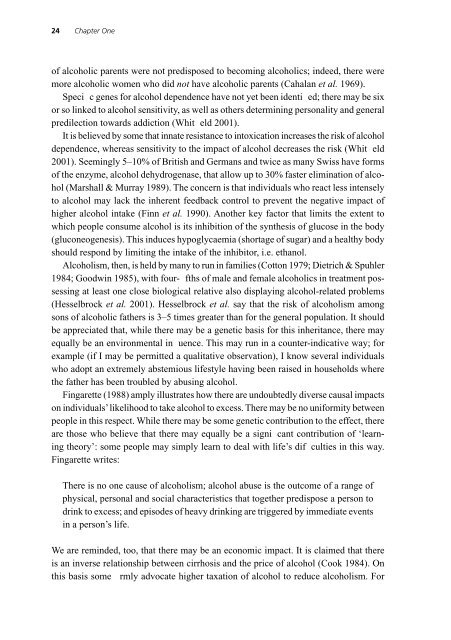Beer : Health and Nutrition
Beer : Health and Nutrition
Beer : Health and Nutrition
You also want an ePaper? Increase the reach of your titles
YUMPU automatically turns print PDFs into web optimized ePapers that Google loves.
24 Chapter One<br />
of alcoholic parents were not predisposed to becoming alcoholics; indeed, there were<br />
more alcoholic women who did not have alcoholic parents (Cahalan et al. 1969).<br />
Speci c genes for alcohol dependence have not yet been identi ed; there may be six<br />
or so linked to alcohol sensitivity, as well as others determining personality <strong>and</strong> general<br />
predilection towards addiction (Whit eld 2001).<br />
It is believed by some that innate resistance to intoxication increases the risk of alcohol<br />
dependence, whereas sensitivity to the impact of alcohol decreases the risk (Whit eld<br />
2001). Seemingly 5–10% of British <strong>and</strong> Germans <strong>and</strong> twice as many Swiss have forms<br />
of the enzyme, alcohol dehydrogenase, that allow up to 30% faster elimination of alcohol<br />
(Marshall & Murray 1989). The concern is that individuals who react less intensely<br />
to alcohol may lack the inherent feedback control to prevent the negative impact of<br />
higher alcohol intake (Finn et al. 1990). Another key factor that limits the extent to<br />
which people consume alcohol is its inhibition of the synthesis of glucose in the body<br />
(gluconeogenesis). This induces hypoglycaemia (shortage of sugar) <strong>and</strong> a healthy body<br />
should respond by limiting the intake of the inhibitor, i.e. ethanol.<br />
Alcoholism, then, is held by many to run in families (Cotton 1979; Dietrich & Spuhler<br />
1984; Goodwin 1985), with four- fths of male <strong>and</strong> female alcoholics in treatment possessing<br />
at least one close biological relative also displaying alcohol-related problems<br />
(Hesselbrock et al. 2001). Hesselbrock et al. say that the risk of alcoholism among<br />
sons of alcoholic fathers is 3–5 times greater than for the general population. It should<br />
be appreciated that, while there may be a genetic basis for this inheritance, there may<br />
equally be an environmental in uence. This may run in a counter-indicative way; for<br />
example (if I may be permitted a qualitative observation), I know several individuals<br />
who adopt an extremely abstemious lifestyle having been raised in households where<br />
the father has been troubled by abusing alcohol.<br />
Fingarette (1988) amply illustrates how there are undoubtedly diverse causal impacts<br />
on individuals’ likelihood to take alcohol to excess. There may be no uniformity between<br />
people in this respect. While there may be some genetic contribution to the effect, there<br />
are those who believe that there may equally be a signi cant contribution of ‘learning<br />
theory’: some people may simply learn to deal with life’s dif culties in this way.<br />
Fingarette writes:<br />
There is no one cause of alcoholism; alcohol abuse is the outcome of a range of<br />
physical, personal <strong>and</strong> social characteristics that together predispose a person to<br />
drink to excess; <strong>and</strong> episodes of heavy drinking are triggered by immediate events<br />
in a person’s life.<br />
We are reminded, too, that there may be an economic impact. It is claimed that there<br />
is an inverse relationship between cirrhosis <strong>and</strong> the price of alcohol (Cook 1984). On<br />
this basis some rmly advocate higher taxation of alcohol to reduce alcoholism. For

















